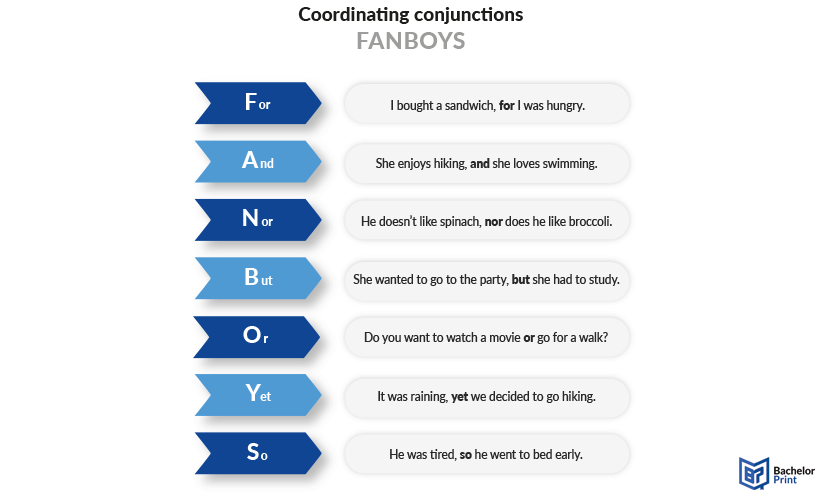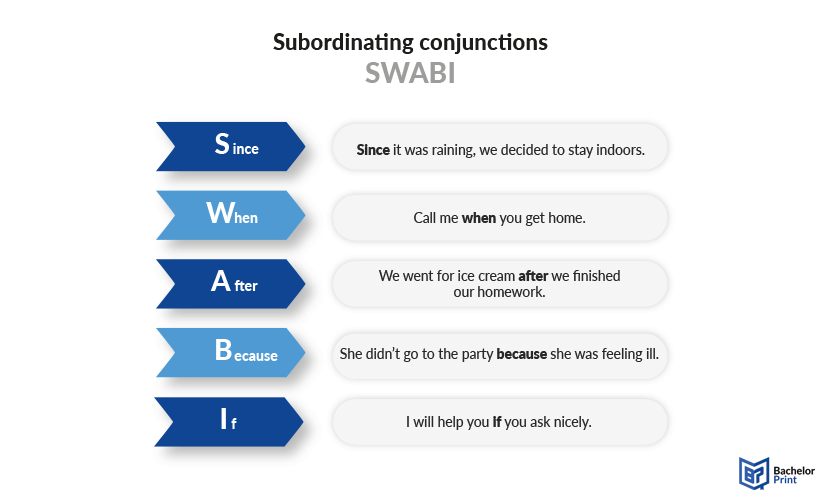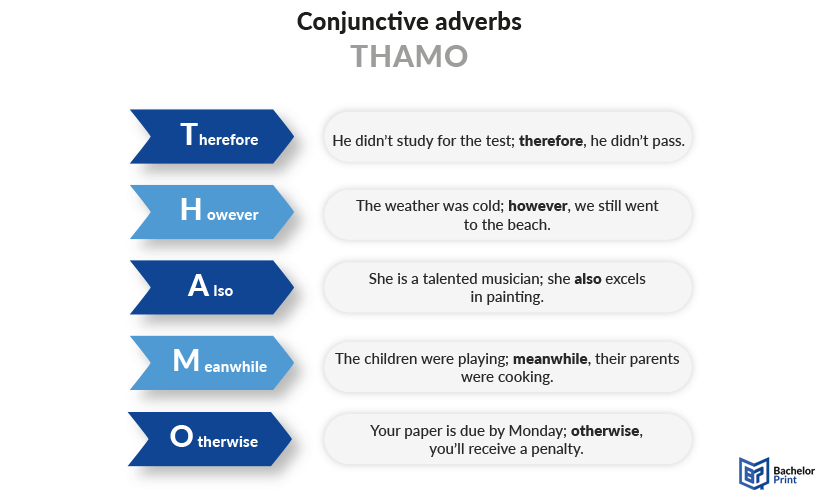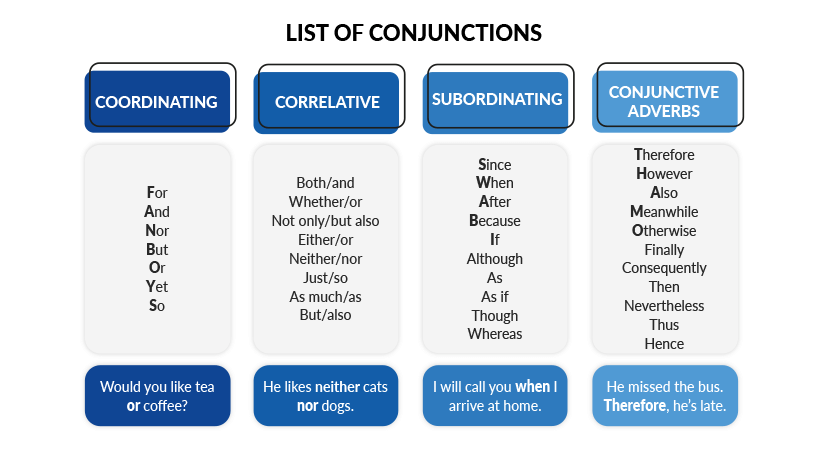
Conjunctions are fundamental components of the English language, serving as essential connectors to join words and clauses within sentences. Understanding and correctly using them is a critical aspect of mastering language rules. These small but mighty words enable you to create complex sentences and improve the flow of your academic writing. In this article, we’ll explore the primary types and demonstrate how they enhance the coherence of our communication through examples.
Definition: Conjunctions
In English grammar, certain words are used to link together clauses and words within the same clause to make complete sentences. These linking words serve to provide coherence and flow to language, especially in academic writing. The English language has numerous joining words, but the most common ones include: when, and, because, or, if, and for. They act as glue that holds together the different parts of our language, ensuring that our communication is smooth and effective instead of simple and choppy.
There is also a famous animated musical called “Conjunction Junction,” performed by popular American artists such as Jack Sheldon, which was featured in a “Schoolhouse Rock” episode in the 1970s. It’s a series of short videos that demonstrate various songs designed to teach multiplication, tables, grammar, science, American history, and environmentalism through music.
Types of conjunctions
There are three major types of conjunctions in the English language: correlative, coordinating, and subordinating conjunctions. All three will be explained below, together with numerous examples and a fourth type that often gets forgotten.
Correlative (or paired) conjunctions are coupled, as they work in pairs to grammatically connect words or phrases that have equal elements. Common correlative pairs include the following: either & or, neither & nor, both & and, and whether & or. You don’t have to place a comma when using correlative conjunctions.
It’s vital to use a parallel structure for both sentence elements when using correlative conjunctions. This means the two components should have a similar grammatical form.
In English grammar, these seven words connect phrases, words, or independent clauses of equal importance. They can be easily memorized with the acronym FANBOYS: for, and, nor, but, or, yet, so. Coordinating conjunctions can connect two verbs, phrases, adjectives, nouns, or any other type of word. When it comes to using a comma with fanboys, you should not use it when they link dependent clauses.
An independent clause is a clause that stands on its own and still creates a complete thought. When a coordinating conjunction joins two independent clauses, place a comma before it. In the sentence below, you can notice that these two sentences can still make sense alone, yet seem more sophisticated when they’re connected to one another.

These words are mainly used to connect an independent clause with a dependent one, showing the relationship between them. While there are more subordinating conjunctions, there’s an abbreviation and acronym to help you remember them: SWABI, as in since, when, after, because, and if. Dependent or subordinate clauses are words that contain a subject and a verb but can’t make a complete sentence on their own, which is why they must have an independent clause.
| Sentence type | Example |
| Dependent clause | Because I had work to do the next morning. |
| Independent clause | I had to sleep early. |
| Complete sentence | I had to sleep early because. I had work to do the next morning. |
You may have noticed that you don’t place a comma when the subordinating conjunction follows an independent clause. However, it would be beneficial to put a comma after the dependent clause when the subordinating conjunction begins a sentence, as seen in the example below.
Subordinating conjunctions help define the type of relationships between the clauses. Here are some of these words and the relationships they help express:
| Relationship | Conjunctions |
| Cause and effect | as, since, because |
| Time | after, before, once, while, whenever, since, when |
| Place | where, wherever |
| Condition | in case, if, unless |
| Contrast | though, although, whereas |

Conjunctive adverbs are words or phrases that connect two complete thoughts. They can be used to indicate a connection between two independent clauses, link the ideas in two or more sentences, or show a relationship between them. Unlike coordinating conjunctions, conjunctive adverbs are typically followed by a semicolon or a period.
There’s a helpful mnemonic to remember them: THAMO as in therefore, however, also, meanwhile, and otherwise. However, there are many others, such as finally, consequently, indeed, thus, hence, etc. When it connects two independent clauses in one sentence, it is vital to place a semicolon before it and a comma after it.
While conjunctive adverbs typically appear at the beginning of a clause, they can also be placed in the middle or at the end for emphasis and set off by commas, though this is less common. This can be illustrated in the example sentences below.


Below, we have provided a PDF document that encompasses all types of conjunctions.
“That” as a conjunction
The term “that” has several functions in the English language, such as a relative pronoun, and an informal adverb, just to name a few. An important use of “that” is to insert a specific type of dependent clause, also known as a noun clause, within an independent clause. These noun clauses can serve as the subject or object of a reporting verb (found, reported, argued, claimed, etc.) to introduce a paraphrase, summary, or quotation, as can be seen in the example sentences below.
Subject = gray, bold; verb = underlined; object = italics, blue
An easy way to figure out that the “that” clauses act as direct objects is to rephrase these sentences into questions. The answer is the direct object.
- What did the scientists hypothesize?
- What did Jones (2018) argue?
- What did she claim?
The majority of academic writers choose to keep “that” for clarity when it introduces a noun clause, as omitting it can cause unnecessary confusion.
Cultural & linguistic variations
While the concept of conjunctions is universal, their usage and forms can vary significantly across different languages. Understanding these cultural and linguistic variations can provide more profound insights into how different languages construct meaning and coherence in communication. Below, you’ll find numerous examples from languages such as Spanish, French, Italian, and German.
Coordinating
English: “and”
Spanish: “y”
French: “et”
German: “und”
Italian: “e”
English: “but”
Spanish: “pero”
French: “mais”
German: “aber”
Italian: “ma”
Subordinating
English: “because”
Spanish: “pero”
French: “parce que”
German: “weil”
Italian: “perché”
English: “although”
Spanish: “aunque”
French: “bien que”
German: “obwohl”
Italian: “sebbene”
Correlative
English: “either…or”
Spanish: “o…o”
French: “soit…soit”
German: “entweder…oder”
Italian: “o…o”
English: “neither…nor”
Spanish: “ni…ni”
French: “ni…ni”
German: “weder…noch”
Italian: “né…né”
Test yourself!
Practice sheet
To test your skills, we have provided a practice worksheet for you below that gives you several conjunction options from which you can choose from, but not all of them are correct. Pick the correct one and fill in the blanks; the answers can be found in the second tab.
- He wanted to join the team, ____ he missed the registration deadline. (or / and / but)
- The task seemed simple, ____ it took hours to complete. (if / yet / because)
- The course covers ____ theoretical ____ practical aspects. (both, and / neither, nor / as much, as)
- She forgot her umbrella, ____ she got soaked in the rain. (so / while / since)
- They listened to music ____ they cleaned the house. (where / while / whenever)
- She enjoys painting, ____ she often creates new artwork. (but / unless / and)
- He likes food that is ____ sweet ____ sour, preferring spice. (either, or / both, and / neither, nor)
- He hasn’t decided ____ to apply for the job ____ continue his studies. (whether, or / if, or / unless, or)
- You won’t get better ____ you practice regularly. (if / unless / but)
- ____ I appreciate your help, I need to do this on my own. (whenever / when / while)
- He wanted to join the team, but he missed the registration deadline. (or / and / but)
- The task seemed simple, yet it took hours to complete. (if / yet / because)
- The course covers both theoretical and practical aspects. (both, and / neither, nor / as much, as)
- She forgot her umbrella, so she got soaked in the rain. (so / while / since)
- They listened to music while they cleaned the house. (where / while / whenever)
- She enjoys painting, and she often creates new artwork. (but / unless / and)
- He likes food that is neither sweet nor sour, preferring spice. (either, or / both, and / neither, nor)
- He hasn’t decided whether to apply for a job or continue his studies. (whether, or / if, or / unless, or)
- You won’t get better unless you practice regularly. (if / unless / but)
- While I appreciate your help, I need to do this on my own. (whenever / when / while)
- ✓ Free express delivery
- ✓ Individual embossing
- ✓ Selection of high-quality bindings
FAQs
They are crucial in writing and speech, as they…
- Connect ideas smoothly
- Clarify the relationship between different parts of a sentence
- Improve the flow and coherence
- Help in avoiding short, choppy sentences by combining ideas
Without these words, you would likely express your complex thoughts using multiple simple sentences, which might be ineffective.
Yes, however, one must be a subordinating one (although, after, because, since, etc.) and the other a coordinating one (yet, so, nor, but, etc.).
Example
- She slipped and fell into the waters, but not because she was intoxicated.
Examples of subordinating conjunctions are: because, although, since, if, while, after, before, when, unless, and, though.
Examples of coordinating conjunctions are: and, but, or, nor, for, yet, and so.
